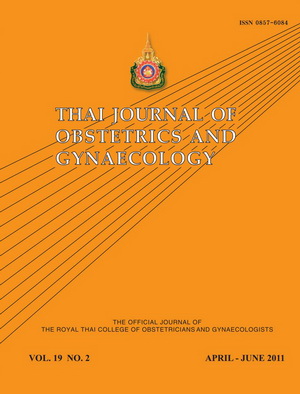Residual Disease in Hysterectomy Specimens after Loop Electrosurgical Excision or Cold Knife Conization in High Grade Squamous Intraepithelium Lesion and Microinvasive Cervical Carcinoma
Main Article Content
Abstract
Objective:
To study the residual disease in subsequent hysterectomy specimens after loop electrosurgical excision (LEEP) or cold knife conization (CKC) and its correlation with adequacy of margins in previously excised specimens.
Materials and Methods: Medical records and microscopic specimens of patients who were diagnosed as high grade squamous intraepithelial lesion (HSIL) or microinvasive cervical carcinoma (MIC) in LEEP or CKC specimens with subsequently hysterectomy within 6 months after the diagnosis from January 1, 1999 to April 30, 2009 were reviewed. Adequacy of margins and residual lesion were specifically evaluated.
Results: Of 156 cases, 87 of them (55.8%) had positive margin in LEEP/CKC specimens, whereas residual disease was identified in hysterectomy specimens in 73 cases (46.8%). There was no significant difference of residual tumor in the uterus between positive- and negative-margin of LEEP/CKC specimens (p=0.61). Comparing between LEEP and CKC, positive margin was significantly higher in LEEP specimens (72.9% vs. 47.3%, P=0.004), but the presence of residual diseases in hysterectomy specimens was similar between both groups and was not related to the marginal status. The numbers of positive margin sites in LEEP/CKC specimen were positively correlated to the residual disease in the uterus. Invasive squamous cell carcinoma was identified in the hysterectomy specimen of case that had negative margin of CKC specimen.
Conclusion: There was high prevalence of residual disease in uterus following LEEP/CKC. Patients with increased numbers of positive margin sites in LEEP/CKC specimens tended to have more residual disease. Positive margins were more common in patients who underwent LEEP than CKC. Negative margin status could not rule out invasive residual disease in hysterectomy specimen.

